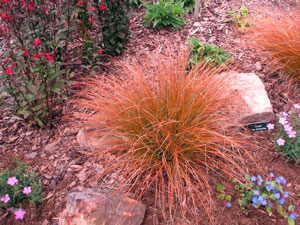Resource Library
Plant of the Week: Sedge, Orange
The University of Arkansas System Division of Agriculture does not promote, support or recommend plants featured in "Plant of the Week." Please consult your local Extension office for plants suitable for your region.
Plant of the Week
Orange Sedge
Latin: Carex testacea

The grass craze hit the gardening world about 25 years ago, and we gardeners were deluged with lots of new grasses and grass-like plants to use in the garden. While the introduction of new grasses seems to have cooled, interest remains high in some of the grass-like plants, especially sedges. In the early years of this century, a colorful foliage plant known as Orange (or Copper) New Zealand sedge (Carex testacea) appeared in the market and has become increasingly popular.
Orange New Zealand sedge is one of the narrow-leafed, grass-like sedges that grows to about 18 inches tall with a spread of 24 inches. Its wispy evergreen leaves are about 1/16th inch wide and arise from a tight crown. In the summer, plants typically are greenish orange in color, but turn orange to copper-brown during the fall and winter. A seed spike is produced in late spring but is of little ornamental interest.
The Carex are a large group (estimates range from 1,100 to 2,000 species) of ancient plants in the cypress family with worldwide distribution that evolved at least 200 million years ago. Most sedges evolved in a wetter world, so they tend to favor marshy or swampy habitats. Though they look like grasses, they are only distantly related. Grasses came to dominate the world as it dried out after the K-T extinction event that killed the dinosaurs 65 million years ago.
Sedges have triangular stems, though on fine-textured species such as Carex testacea, this characteristic is difficult to spot except when the flowering spike emerges in the spring. The genus name is the ancient Greek name for the plants and was chosen by Linnaeus for the group; the epitaph translates from Latin as “brick-colored,” a reference to the foliage coloration.
This and several other new sedges were developed by a Dutch seed company called Kieft-Pro-Seed under the trademarked name of Carex Colorgrass. In May 2009, the company was purchased by Ball Horticulture Inc. of West Chicago, Ill.. to partner with their own seed brand, Pan-American Seed. The most common offering of Carex seems to be ‘Prairie Fire’ TM, but they also offer slightly different trademarked selections, such as ‘Red Rooster,’ ‘Bronco,’ ‘Bronzita’ and a green form called ‘Phoenix Green.’ Seed is typically planted by greenhouse plug growers in midsummer for sale the following spring by retail growers.
Orange sedge is easy to grow. It should be planted in a well-drained, sunny bed amended with organic matter. Once established, orange sedge will tolerate moderate drought, but leaf tips will burn and the plant will become unsightly if dry conditions prevail too long. Allow the foliage to remain in place over winter to enjoy the contrasting color with the surrounding vegetation. In the spring, run a rake through the plant and comb out the old, dead leaves instead of cutting it back. The plant can be divided in late winter or early spring.
This species is considered one of the most cold-hardy native New Zealanders for temperate gardens. It is hardy to at least zero degrees Fahrenheit (zone 7), but some report it may overwinter as far north as zone 5. It makes a fine accent plant in flowering borders or is an excellent addition to container plantings. It is a favorite container plant for those wishing to prepare a decorative planter for wintertime decoration.
By: Gerald Klingaman, retired
Extension Horticulturist - Ornamentals
Extension News - October 15, 2010
The University of Arkansas System Division of Agriculture does not maintain lists of retail outlets where these plants can be purchased. Please check your local nursery or other retail outlets to ask about the availability of these plants for your growing area.